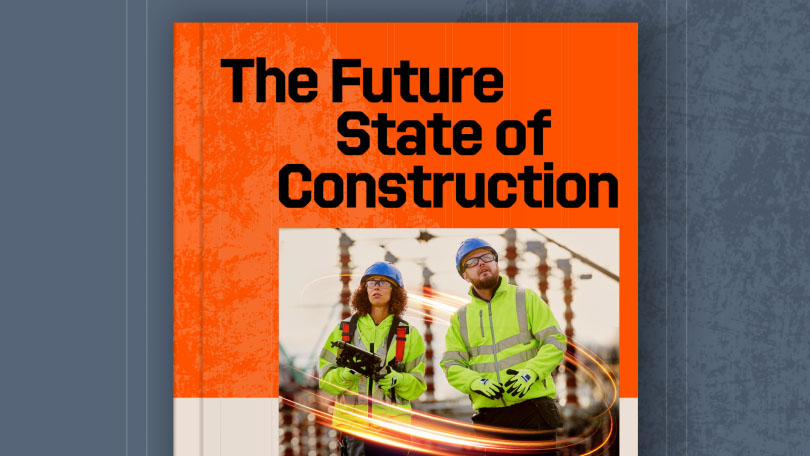— 9 min read
Is Building Safety Act Enforcement Working?


Last Updated Aug 28, 2025

Brett King
Director of Industry Transformation, EMEA
Brett King is a construction industry transformation leader with over 15 years' experience delivering major projects and driving operational excellence across the UK and EMEA. As Director of Industry Transformation at Procore, he helps clients tackle complex challenges—from regulatory compliance and digital adoption to data strategy, AI integration, and change management at scale. With a background in business improvement and tech implementation at leading contractors, Brett bridges site-level realities with strategic outcomes—translating vision into action. A regular speaker, workshop facilitator, and trusted advisor, he’s known for making the complex simple and the theoretical practical. When he’s not driving change in construction, he’s driving greens, chasing Strava segments, or finding the best thing on the menu.

Anna K. Cottrell
Writer and Editor
Anna K. Cottrell is a writer and researcher with an expertise in the property and finance sectors.

Zoe Mullan
27 articles
Zoe Mullan is an experienced content writer and editor with a background in marketing and communications in the e-learning sector. Zoe holds an MA in English Literature and History from the University of Glasgow and a PGDip in Journalism from the University of Strathclyde and lives in Northern Ireland.
Last Updated Aug 28, 2025

The Building Safety Act (BSA) 2022 promised to transform the UK residential construction industry following the Grenfell tragedy. Parliament designed this long-overdue legislation to tackle a system that lacked accountability, clear processes, and decision traceability.
Three years later, however, construction industry leaders, architects, and developers question whether the Act has delivered on its promise. Rather than creating safer buildings, many argue the BSA has generated submission anxiety, with high project rejection rates shifting focus from designing safe buildings to getting submissions 'right'.
This raises critical questions: Can the new enforcement regime truly change the industry? What challenges hinder implementation of the new system? Most importantly, what can organisations do to drive the necessary shift towards greater accountability and efficiency?
Table of contents
How BSR Enforcement Works
The Building Safety Act targeted three long-standing problems in UK construction, particularly high-rise residential projects.
Responsibility
First, it assigned clear responsibility for every stage of a building's lifecycle from design to demolition.
Culture
It then aimed to shift building culture so the industry prioritises safety over cost reduction.
Enforcement
Finally, it introduced tougher enforcement with extended penalties for building safety violations.
The Act established the Building Safety Regulator (BSR), initially within the Health and Safety Executive (HSE). By mid-2025, the BSR operated as a standalone Executive Agency under the Department for Levelling Up, Housing & Communities (DLUHC), reflecting its expanded mandate and independence. The BSR now holds sole authority for enforcing building safety in higher-risk buildings (HRBs) – residential buildings over 18 metres or seven storeys tall.
Addressing Past System Failures
Centralising building safety regulation tackled fundamental problems with the previous system based on the Building Act of 1984 and the Fire Safety Order of 2005. Under the old rules, local councils bore responsibility for assessing and enforcing building safety, but their powers were severely limited in both time and scope.
Councils had only 12 months to take action against non-compliance, and violations typically resulted in fines. Moreover, councils often lacked complete access to building safety information because, in England and Wales, privately appointed building inspectors could carry out building design approvals, making information subject to commercial confidentiality laws.
The new system grants the BSR full access to all building design information and authority to pursue building safety violations for up to 10 years, with unlimited fines or even imprisonment as possible consequences. However, enforcement represents just one aspect of the reform.
The Grenfell Inquiry found that the existing building regulatory system permitted poor record-keeping, manipulated safety test results, failure to disclose contract obligations, and other regulatory failures that collectively created a culture of unaccountability. By subjecting all HRB projects to a standardised process of submission, inspection, and record-keeping, the Act sought to eliminate the fragmentation that had previously enabled building safety violations.
The Gateway System
The BSR processes building applications in stages, with Gateway 2 emerging as the most challenging checkpoint. At this stage, developers (or Principal Contractors) submit detailed design plans that require BSR approval before construction begins.
After Gateway 2 approval and completion of building work, the compliance journey concludes with Gateway 3, when the BSR makes a final occupancy decision and issues a completion certificate. However, Gateway 3 remains untested since no projects have yet reached this final step, meaning the BSA's full enforcement cycle remains incomplete.
New Roles and Requirements
The BSA compliance process requires several key roles for every HRB project, including a Building Regulations Principal Designer (BRPD) – distinct from the Principal Designer who coordinates health and safety aspects pre-construction for all projects, regardless of HRB status.
Additionally, the Safety Act mandates that every building owner maintain a detailed digital record of all project aspects, from design to suppliers and materials used. This 'golden thread of information' aims to strengthen accountability and compliance.
Theoretically, this multi-pronged approach should help UK building culture prioritise safety. However, three years on, industry professionals identify several obstacles to successful enforcement. Some stem from poor communication between the regulating body and industry, while others reflect incompatibility between modernising goals and current capabilities of both the BSR and construction industry.
Current Implementation Challenges
The main challenges to effective BSA compliance currently stem from capacity and resource issues: shortage of qualified building inspectors, possible backlog in approvals, and time constraints.
Inspector Shortages Create Bottlenecks
BSR-registered building inspectors must conduct several site visits throughout building projects for approval. Under the new rules, existing building surveyors need re-assessment to qualify as building control approvers and must navigate 'more oversight and tighter rules regarding high-risk buildings.'
When Parliament passed the Act, building surveyors averaged mid-to-late 50s in age, leading to an exodus of professionals who chose early retirement over the "challenges of the BSR," according to PBC Today.
Today's shortage of qualified building inspectors remains severe. Despite recruitment drives, the problem has forced one council in Chelmsford to suspend inspections entirely due to staff shortages.
Application Backlogs Mount
While councils struggle to replenish their building inspector rosters, the BSR battles its own application backlog. "Only 6% of new building applications are approved within the allotted 12-week period," according to the Fire Industry Association (FIA). Research into Gateway 2 submissions reveals that of 187 applications submitted between October 2023 and end of June 2025, 149 had received no decision, remaining stuck in regulatory limbo.
The primary cause of this backlog is an extraordinarily high Gateway 2 application rejection rate of 75%. Applications face rejection "due to vital information being incorrect or simply missing."
Industry Knowledge Gaps Persist
Growing evidence suggests that construction and development industries currently lack sufficient knowledge about the Act's provisions. Architects report spending additional time educating clients about new obligations, and many cases reveal poor appreciation of non-compliance consequences.
The BSA is shining a light on an uncomfortable truth: most firms can't even find their project records, let alone maintain a golden thread. Until we treat data as critical infrastructure, enforcement won't move the dial.

Brett King
Director of Industry Transformation, EMEA
Procore Technologies
One major source of confusion involves the common misconception that only high-risk buildings (HRBs) require appointing a Building Regulations Principal Designer alongside the Principal Designer. In fact, the Act requires a BRPD whenever projects involve multiple contractors. Also, clients must appoint the BRPD at the design conception stage, not simply before building starts.
The same applies to Principal Contractor (PC) roles. Many clients remain unaware that they must attach a PC to projects from the beginning. Clients cannot appoint a PC in addition to an existing main contractor at later project stages. If existing contractors cannot or will not assume PC roles, clients must restart the entire process and hire different contractors capable of carrying out PC duties.
The implications of incorrectly assembling project teams are profound and can lead to significant setbacks. Strong early-stage decisions, particularly in appointing the right people for correct roles, directly impact later project lifecycle outcomes.
Communication Gaps Hinder Progress
Better communication between clients and the Regulator at early process stages could smooth out many current issues. Currently, many industry professionals find the concept of a 'good-enough' submission unclear.
"Some people are submitting one page, others 300 CVs," according to Justin Van Walwyk, pre-contract director at Briggs & Forrester.
This lack of process confidence often leads to misdirected or overzealous compliance efforts that don't necessarily improve building safety as the Act intended.
Scott Manton, HSE director at Kao Data, observed during a Procore industry roundtable that, "Competence isn't just someone that has gone and done a training scheme to tick a box; it's the people who have the knowledge and the skills to make sure a building is delivered safely."
Clients would benefit from developing systems and processes that enable better assessment and tracking of everyone's competencies throughout projects, beyond compliance rule requirements. Early regulator communication could redirect energies towards meaningful competency tracking rather than just Gateway submissions.
BSR Structural Problems
Industry leaders have raised concerns about structural and cultural issues that have limited BSR effectiveness in enforcing the Building Safety Act. By late summer 2025, the BSR underwent significant reform following a government inquiry.
As part of these reforms, the BSR now operates as a standalone, government-controlled regulating body no longer within the Health and Safety Executive. However, the regulator still experiences significant human resource issues, lacking sufficient qualified professionals to undertake application reviews and contributing to current backlogs.
To clear backlogs and accelerate Gateway application processing times, additional building inspectors and engineers will join the BSR directly. The plan involves recruiting 100 new staff members by year-end.
Practical Compliance Strategies
Greater transparency and earlier communication between the BSR and building clients would undoubtedly encourage more effective planning while reducing errors and resubmissions.
Build Compliance Teams Early
Given the extensive detail required and the need for ongoing communication, most firms benefit from forming project "compliance teams" to track evolving regulations and maintain thorough documentation for each project stage.
Engage the BSR Proactively
Contacting the BSR before issues arise is another crucial step for ensuring smooth, successful applications.
Deploy Digital Solutions
Digital tools and systems are essential for tracking even small changes as projects evolve, especially regarding human resources. Digital interventions make it easier to track individual competencies across different projects, not just roles.
UK building quality still suffers from competency gaps in areas less well-tracked than BRPD qualifications. Building materials may simply be installed incorrectly during construction due to one worker's lack of knowledge. Digital competency tracking systems could ensure greater accountability for everyone involved in projects, regardless of seniority or when they joined.
Thomas Richardson, Industry Advisor at Procore has proposed opening access to the regulator so "they can engage directly with the contractors around things such as notifiable changes."
Gateway 2 Case Study: Common Pitfalls
Consider a scenario where the BSR delays or rejects a Gateway 2 application. Despite extensive submitted documentation, why didn't the application receive timely approval?
The problem often lies in submissions failing to clearly outline how building designs fulfil BSR requirements. Even when developers lack understanding of requirements rather than intentionally providing vague information, the outcome remains unchanged: wasted money and resources for undeveloped site upkeep, extended loan financing duration, and increased inflationary expenditure for materials and labour.
Andrew Moore, BSR head of operations, has noted that "Developers frequently submit applications that are vague or lacking information in the hopes that the BSR will confirm their claims." Such proposals "just include supporting documentation without describing how the project complies with the rules."
Early, proactive BSR communication can prevent all of this. Lacking clarity on exact Gateway 2 requirements is acceptable – that's precisely why Procore's collaborative, proactive, and detailed approach to engaging with the regulator throughout the process makes such a significant difference.
Looking Ahead
In the coming months and years, projects receiving BSR approval will undoubtedly be those that diligently and proactively address Gateway 2 requirements in effective, evidenced formats. While official guidance clarifications will help, most firms submitting BSR applications will likely need structured and innovative approaches beyond simply submitting extensive supporting documentation and hoping for the best.
Construction software innovators like Procore will lead efforts helping developers navigate the new system successfully by assisting firms in delegating submissions to specialised teams with appropriate tools and open BSR communication channels. Consider the possibilities that better processes offer beyond mere compliance. For firms still relying on spreadsheets and siloed systems, the BSA isn't the biggest risk – lack of readiness is.
Categories:
Preconstruction, Project Management, Risk Management, Safety and Compliance
Written by

Brett King
Director of Industry Transformation, EMEA | Procore Technologies
Brett King is a construction industry transformation leader with over 15 years' experience delivering major projects and driving operational excellence across the UK and EMEA. As Director of Industry Transformation at Procore, he helps clients tackle complex challenges—from regulatory compliance and digital adoption to data strategy, AI integration, and change management at scale. With a background in business improvement and tech implementation at leading contractors, Brett bridges site-level realities with strategic outcomes—translating vision into action. A regular speaker, workshop facilitator, and trusted advisor, he’s known for making the complex simple and the theoretical practical. When he’s not driving change in construction, he’s driving greens, chasing Strava segments, or finding the best thing on the menu.
View profile
Anna K. Cottrell
Writer and Editor | Freelance
Anna K. Cottrell is a writer and researcher with an expertise in the property and finance sectors.
View profileReviewed by

Zoe Mullan
27 articles
Zoe Mullan is an experienced content writer and editor with a background in marketing and communications in the e-learning sector. Zoe holds an MA in English Literature and History from the University of Glasgow and a PGDip in Journalism from the University of Strathclyde and lives in Northern Ireland.
View profileExplore more helpful resources

Control the Chaos: Standardising Document Workflows in Construction Projects
Document control and implementation play a central role in managing risk, meeting deadlines, and delivering projects to spec. As builds become more complex and teams increasingly disperse, the volume and...

Cost-Plus Construction Contracts in the UK
A construction cost-plus contract – sometimes called a cost-reimbursable or prime cost contract – reimburses all project costs and adds a fee to cover the contractor’s overhead and profit. UK...

Digital Construction Technology for Whole-Life Value
For decades, the construction industry has kept a narrow focus on capital cost — the one-time, upfront costs of a construction project. While in the short term this seems like...

UK Construction Progress Reports: Tools for Smarter Site Management
Construction progress reports track completed work, on site issues, costs, and safety so UK project teams can demonstrate progress, secure payments, and stay on programme. Accurate progress data is essential...
